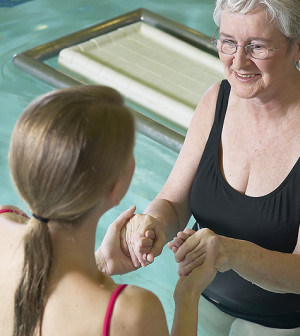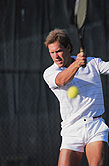- Strengthening Your Relationship: Practical Strategies
- Skip Storing This Everyday Product in the Fridge Door
- Green Tea + B3 Pairing May Boost Brain Health
- Navigating Your Midlife Crisis: Embracing New Possibilities
- City Raccoons Showing Signs of Domestication
- Mapping the Exposome: Science Broadens Focus to Environmental Disease Triggers
- One Week Less on Social Media Linked to Better Mental Health
- Your Brain Changes in Stages as You Age, Study Finds
- Some Suicide Victims Show No Typical Warning Signs, Study Finds
- ByHeart Formula Faces Lawsuits After Babies Sickened With Botulism
‘Tennis Elbow’ Usually Heals Without Therapy, Study Finds


Most people with tennis elbow recover without physical therapy and steroid injections, according to a study by researchers in Norway.
“I’m not surprised because that’s really been the classic teaching,” said Dr. Joshua Dines, an orthopedic surgeon at the Hospital for Special Surgery in New York City. “The number that’s often cited is that 90 percent of tennis elbow, golfer’s elbow, will get better by the end of the year no matter what you do.”
Study first author Dr. Morten Olaussen, a specialist in family medicine at the University of Oslo, agreed that the finding was expected. But, he added, “it is interesting to note that after one year, as much as one-third of the patients still reported considerable discomfort.”
What was surprising, said Olaussen, was that physical therapy was not effective. “It has been shown to be effective in earlier research but then on more chronic conditions,” he said.
In their study, published recently in BMC Musculoskeletal Disorders, Olaussen and his colleagues looked at outcomes for 177 Norwegian patients with a recent onset of tennis elbow pain.
Symptoms of tennis elbow include a weak grip and pain from damage to tendons in the forearm. Often, this happens from repetitive use, such as with tennis, golf or carpentry.
The patients in this study had experienced their symptoms for up to three months. Each was randomly assigned to one of three groups: either no treatment except for drugs such as naproxen (Aleve); physical therapy for 12 sessions along with two corticosteroid injections to reduce inflammation; or 12 sessions of physical therapy and two placebo injections.
Patients underwent the therapies for six weeks, and they were tracked for one year. At the end of that time, 157 people had completed the study.
Overall, improvement with physical therapy plus placebo injection or steroid injection was about the same as with no treatment at all. For three-fourths of the patients, the elbow pain had disappeared at one year, regardless of which group they were in.
But at least one-quarter still had symptoms at one year.
Olausson and his colleagues found that at the six-week point, physical therapy combined with steroid injections was helpful compared to placebo injections with physical therapy. But for most outcomes, physical therapy with steroid injections was linked to worsening at 12 weeks and 26 weeks after initial reports of improvement.
The study authors wrote that the steroid might have reduced pain temporarily but delayed tendon repair. So patients felt better around the time of injections but then felt worse several months later.
Dines, who is also an assistant physician for the New York Mets baseball team, said research indicates that “if you get through about six months and haven’t gotten better with some sort of conservative treatment, that’s the group that’s going to go on to need surgery.”
Some people will still wait a year, he said, because they keep trying one of the “million different” nonsurgical treatment options for tennis elbow. According to Dines, these treatments can include Botox injections, massage, physical therapy and shock wave treatment.
If persistent pain brings a patient in for consultation, Dines said that the first thing a physician can do is “give some structure with regards to returning to their activity.”
After waiting until they feel no pain with most activities, for example, a patient could try tennis again for five minutes, take a break, and do another five minutes, he suggested. “Then shut it down and take a day off, build up slowly, and as long as they can continue to improve without pain, then we consider it a successful treatment.”
If that approach is unsuccessful, then surgery is the next step, he said.
Unfortunately, said Dines, no one can look at a patient’s elbow problem and tell right away if surgery will be the final outcome. “If I could answer that, I’d be able to retire,” he said, “because being able to predict who’s going to get better and who’s not would allow me to save some people a year of their lives.”
More information
The American Academy of Orthopaedic Surgeons has more about tennis elbow.
Source: HealthDay
Copyright © 2025 HealthDay. All rights reserved.










